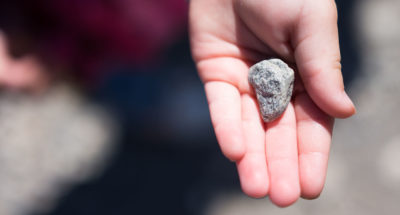
Mindful Seeing for Elementary Students
A mindfulness practice in which students develop their ability to focus by closely observing the shape and contours of a small rock.

A mindfulness practice in which students develop their ability to focus by closely observing the shape and contours of a small rock.
Students will:
Before leading this practice, find a small rock or stone for children to use as a “focus rock.” (You can make a fun outing of going on a walk to find a special rock!)
For this exercise, we’re going to pay attention to seeing.
We’ll pay attention to what it’s like to look very closely at something, noticing all the details of what we see right now in this moment.
Before we begin, make sure you have a small rock or stone ready to use for this activity.
And we’ll call it our focus rock.
Now let’s begin.
Sit on the floor with your legs crossed, or you can sit in a chair if that’s more comfortable.
Place your focus rock on the floor in front of you—a little ways from your body—about two feet away.
Rest your hands gently on your knees and sit up tall like a mountain, but keep your neck and shoulders relaxed.
Feel your feet touching the floor.
Feel your legs touching the floor or the chair.
Feel your hands touching your legs.
Feel your back tall and strong.
Let’s start with our eyes closed (if that’s comfortable for you—or feel free to gaze downward).
Close your eyes (or let them remain open), and just notice what it feels like to breathe in and out right now in this moment.
[PAUSE for 10 seconds]
Now open your eyes and look at your focus rock.
What does it look like?
Do you see spots or lines?
You might notice the shape of it—or the outline.
You might notice its color.
Or you might notice it’s not just one color, but has different colors.
Sometimes when you look at something very closely, you notice new things about it that you never noticed before.
And they might change too … the longer you look.
That’s all natural and normal and part of the experience of mindfulness.
So, keep looking at your focus rock.
Make sure your body is still tall like a mountain and also relaxed.
Relax your shoulders and your neck.
And now I’m going to be quiet for a moment, so we can be very still together and just look at our focus rocks for a little bit longer.
I’ll ring the bell, and we’ll look at our focus rocks together for about thirty seconds.
And then I’ll ring the bell when it’s time to stop.
[PAUSE for 30 seconds]
You’ve probably never looked this closely at a rock before, right?
We see rocks all the time, every day, but I bet you almost never notice all the little details like we did today.
Let’s finish by taking big breath in and reaching our hands up to the sky.
And breathe out and place your hands back on your legs again.
If you enjoyed that, you can come back later and look at your focus rock again.
Or you can try mindful seeing with a leaf, a shell, or another object if you want to.
Thanks for sitting and practicing mindfulness with me today.
It was fun looking at our focus rocks together.
While research on the effects of mindfulness on children is still in the early stages, a 2016 review of 12 studies suggests some promising outcomes for young children relative to attention, self-regulation, and motor skills.
A 2014 meta-analysis that focuses on 24 studies of K-12 students demonstrated changes in students’ attention and resilience to stress, including positive emotions, self-esteem, and self-concept. Apart from affecting student well-being, some research studies suggest that mindfulness practices can also foster curiosity and learning.
Many mindfulness practices involve turning inward to observe thoughts, breath patterns, and body sensations. However, mindful seeing, as an alternative, prompts students to turn outward and engage with their world. In this case, students are practicing being fully present to what is right in front of them.
Children may benefit from mindful seeing because this practice asks them to focus on one thing and notice all of its facets and details—a skill that may ultimately improve their executive function (e.g., attention, self-control, memory) and academic achievement.

Are you ready to build a kinder, happier school where everyone belongs? Join Greater Good Educators! Explore the science of well-being in a supportive community of educators from around the world. Registration is now open for the 2025-2026 school year!
Comments